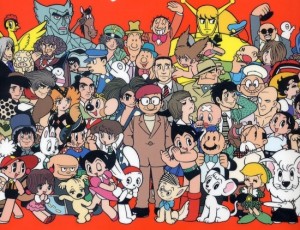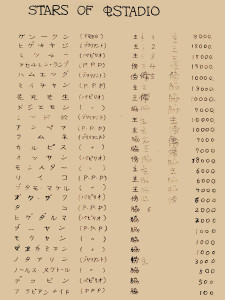Osamu Tezuka’s Star System
One of the unique elements of Tezuka’s work is his use of recurring cast members, characters who appear over and over in different series, with different names and different backgrounds but the same general personality and drives. For example, no matter which story he appears in, a character like Acetylene Lamp will almost always be a villain, often with Hamegg acting as his henchman or crony. By the same token, Shunsaku Ban (a.k.a. Higeoyaji) might play a wide variety of plucky middle-aged man roles.
Tezuka referred to this as his ‘Star System’. The characters were like movie stars in a studio, and he a director reusing the same actors again and again after finding he liked their performances. Tezuka even jokingly made a list of how much they were paid and based them on famous western actors of the time.
Although unique in the world of manga, considering Tezuka was an avid (and often rabid) film and theatre buff, it is not all that surprising that he would approach his manga in much the same way. As Helen McCarthy notes in her wonderful book The Art of Osamu Tezuka: God of Manga, “the Star System is not simply a way of organizing characters, but of expression Tezuka’s central philosophy” (2009, p.37).
It is this re-use of characters, exploring the same personality in multiple lives and circumstances, and in dramatic works like Phoenix (1967-88) even in multiple reincarnations, which gives Tezuka’s work its unique interconnectedness and richness. Tezuka fans love the Star System since it rewards readers for reading multiple series, giving them a silent wink and a nod when they notice Star System characters. It is a delightful reward when you spot, say, Rock Holmes in both Black Jack (1973-83) and Astro Boy (1952-68). It also adds a depth to Tezuka’s storytelling when you first realize that, for example, that Mitchy, the star of Tezuka’s sci-fi adventure Metropolis (1949) and one of his earliest robot protagonists, is also (in both the literal and figurative sense) Astro Boy‘s mother.
It is also interesting to note that due to the fact that numerous kanji all have the same pronunciations in Japanese, characters’ names are usually phonetically identical but written with different kanji from story to story.
Stars of Mushi Studio
| Name | Agency Affiliation | Role Type | Salary (in ¥) |
| Kenichi-kun | (Free) | Lead | 8000 |
| Higeoyaji | (Brilliant) | Lead | 15000 |
| Mitchy | (Papillio) | Lead | 15000 |
| Acetylene Lamp | (P.P.P.) | Secondary | 15000 |
| Hamegg | (Brilliant) | Secondary | 10000 |
| Mii-chan | (P.P.P.) | Minor | 13000 |
| Dr. Hanamaru | (Papillio) | Minor | 10000 |
| Dojiemon | (Papillio) | Minor | 7000 |
| Duke Red | (Brilliant) | Lead | 10000 |
| Anpaa | (P.P.P.) | Secondary | 10000 |
| Ramune | (Brilliant) | Secondary | 7000 |
| Kalpis | (Brilliant) | Secondary | 7000 |
| Ossan | (Papillio) | Minor | 8000 |
| Monster | (Papillio) | Lead | 6000 |
| Riiko | (P.P.P.) | Minor | 6000 |
| Butaru Makeru | (P.P.P.) | Minor | 7000 |
| Boku Zaku | (Papillio) | Secondary | 6000 |
| Tako | (P.P.P.) | Minor | 2000 |
| Higedaruma | (Papillio) | Minor | 2000 |
| Buuyan | (P.P.P.) | Minor | 1000 |
| Mokusan | (P.P.P.) | Minor | 1000 |
| -Illegible- | (P.P.P.) | Minor | 1000 |
| Notaarin | (Brilliant) | Secondary | 3000 |
| Norse Necktall | (Papillio) | Minor | 500 |
| Dekobin | (Papillio) | Minor | 500 |
| Arabian Night | (P.P.P.) | Minor | 100 |




